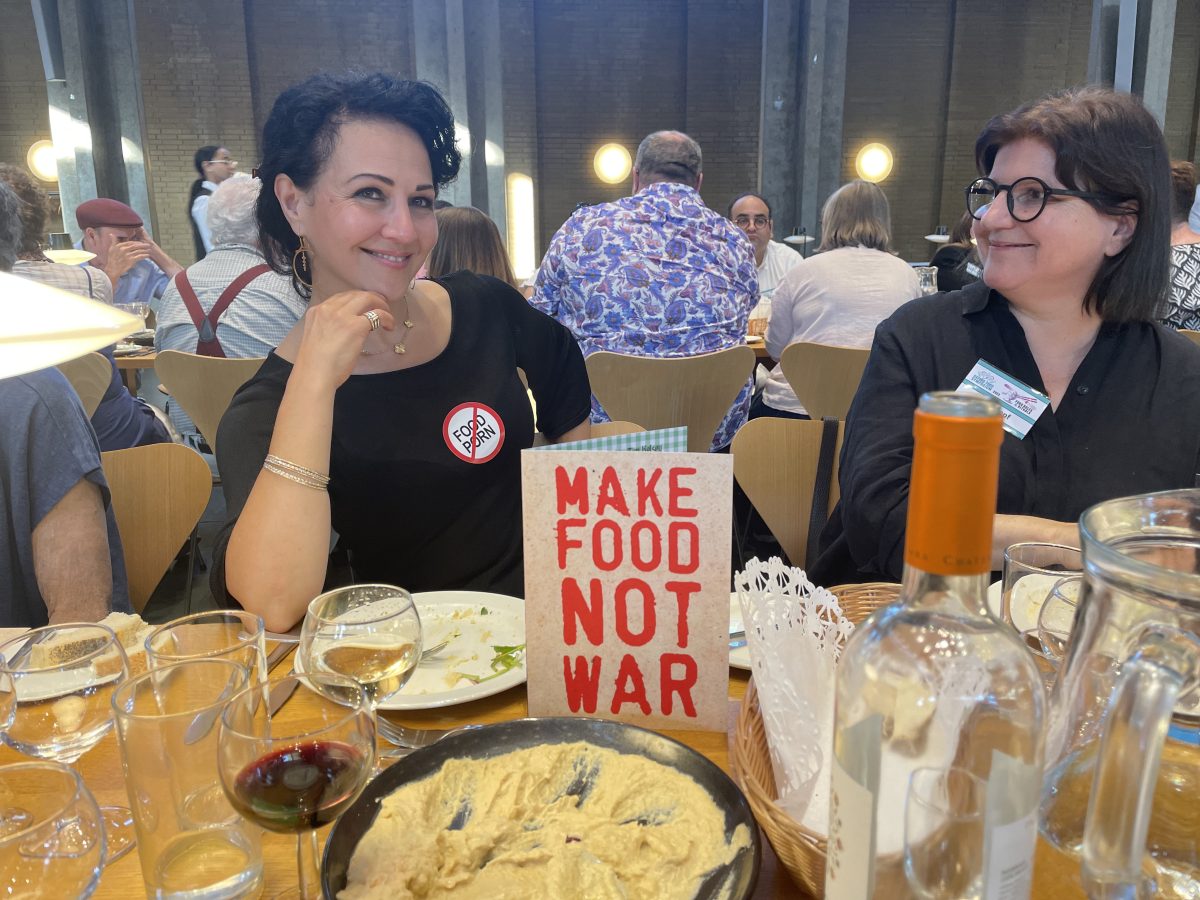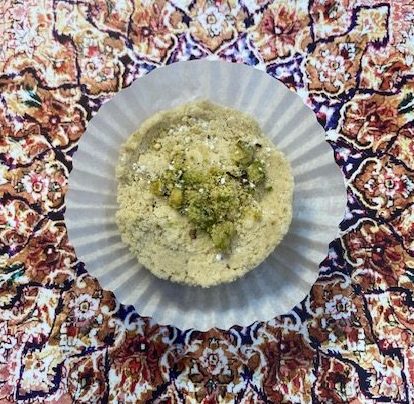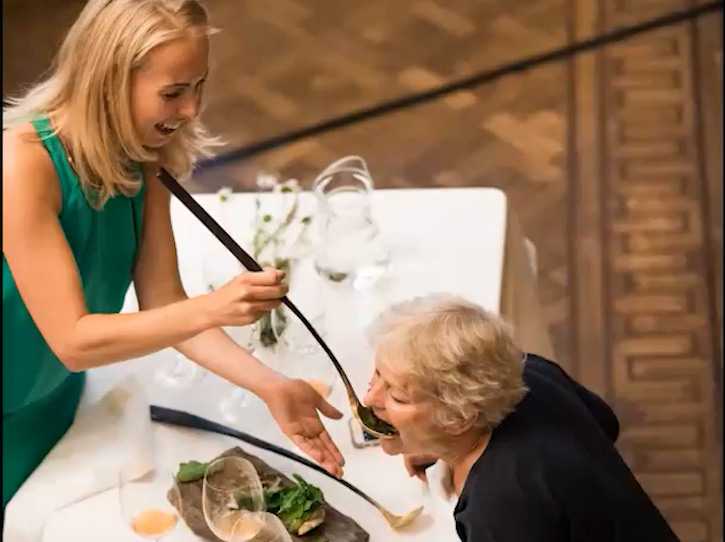
Summing up 2023—thoughts on Rules and Rituals from Scott Alves Barton
“Give thanks by showing reciprocity”
Anishinaabe adage shared by first-time symposiast Cas Gardiner
Please indulge my personal, introductory digression, but this year’s theme of Rules and Rituals hit home, for shortly after the Weekend at St Catz and in the midst of the online Conference, I returned to northeastern Brazil to resuscitate my (Covid-interrupted) ethnographic research into the intersection of sacred and profane Afro-Brazilian foodways through the religious rituals, trances, and shared meals of the Candomblé community. As always, the Symposium discussions informed my ideas while I was in the field.
I knew from my nearly fifteen years of work on the community that participants observe strict protocols during these ceremonies, such as gender-segregated seating, recommended clothing, and, not surprisingly, food. Food offerings are placed on the temple floor, and most reflect the Afro-Brazilian roots of the Candomblé community. I saw agidá, shallow clay bowls filled with beans cooked in coconut milk, mungunza, a sweet corn and coconut porridge, efó, a Nigerian inspired stew of wild and cultivated greens, pirão, a condiment of toasted manioc meal mixed with red yams, and acarajé, black-eyed pea fritters, among others. There was also the occasional Portuguese-inspired dish, such as sarapatel, a pork, offal and blood ragout and coxinha de frango, the breaded shredded chicken encased in béchamel and fried in the shape of a Hershey’s Kiss. All these foods became the comida de axé, dishes imbued with the sacred life force to invoke the power to make change. The same foods are served to congregants and guests at the end of the ritual ceremony and are highly desireable because as axé, they ostensibly give the consumer some of that sacred energy.
Context, subtext and metaphor are embedded in the commensal lexicon. The mixture of dishes reflects the syncretic blend of Yoruba, Indigenous, and Portuguese influences, whether semiotically standing in for white Brazilian culture, such as the coxinha de frango, or the acarajé, that symbolize black Brazilian culture.
My personal curiosity-cum-unease came when, rather than dine with much of the community on the axé dishes that I had enjoyed in years past, I was ushered to a small dining area to eat with the priests and priestesses, a definite honor. There we dined on more Portuguese-inflected foods, such as potato and Russian salads, crepes with ground beef and vegetables, and coxinha de frango. This seemed anomalous. The only logical explanation was that each initiate has a set of dietary taboos, or quizilas, based on their affiliation to their specific orixá (guiding deity) and that these dishes would not violate anyone’s prohibitions. Afterwards, I went in search of aloá, the fermented local beverage that is a cousin to ginger beer and is still made in this temple. Instead, large, 3 liter bottles of Coke and Guarana soda, or small bottles of mineral water were the norm. This further upset my expectations, broke the rules, or (at least) radically bent them for me.

I now journey to the UK and the global village that the Symposium inhabits with my concurrent Brazilian experiences swirling in my mind. Friday’s opening keynote by anthropologist Dimitris Xygalatas, Rituals as Social Technologies, used his work on Spain’s San Pedro Manrique village traditions of firewalking, in which participants walk barefoot on glowing embers, to introduce Durkheim’s idea of “collective effervescence,” ritual engagements that create bonds. Xygalatas’s work is based in biomedical experiments: he measures the physiological reactions via heart rate and cortisol levels of both firewalkers and observers to the joy, pain, anger, or ecstasy experienced during the ritual to track just how closely the physical evidence come to the villagers’ descriptions that they feel “as one heart” during these extreme events; the correspondence of their heart rates bears this out. The bonds were unmistakable: firewalkers and kin had closely parallel biomarkers, while unrelated villagers had similar, if less intense, physical reactions, and outsiders the smallest correlation. Had Dimitris been with me in Brazil, I know in my bones that elevated oxytocin levels would have been off the charts for the supplicants who went into trance, and would have been elevated for all the observers. And while food is not as extreme as firewalking, Dimitris reminded us that sharing a meal creates bonds and, further, that important events have special foods and meals that require efforts well beyond the quotidian; these bring us together “as one.”
Our delicious Friday night dinner, “Lebanon’s Edible Rule Book: Rituals of Entertaining,” devised by activist Kamal Mouzawak and cooked under the guidance of chef Tara Habis of Tawlet in Paris, upended a main practice of many of us: in Lebanon, unlike the rest of the near and middle East, hummus is not served with pita for scooping; instead, it is served with potatoes. And, contrary to our assumptions of the mezze platter being a mix of delectable spreads, dips, and salads, one Lebanese rule of culinary grammar is “No Food, Sex,” a phrase emblazoned on the artistic menus designed by Jake Tilson. That is, these dishes are not co-mingled, but are enjoyed individually in Lebanese style. Extraordinary braised lamb followed, and while we drank wonderful wines and raki to complement the meal, I could not help but wonder about the issue of alcohol: both Kamal and Tara now work in Paris, where the marriage of food and wine is implicit in culinary culture, but how would the experience of the meal differed had we followed strict Muslim practice, that is, we need to consider substitution, refusal and agency within ritual practice. Would the gastrodiplomacy be rent or the meals wrecked if non-alcoholic Lebanese drinks, such as laban ayran, (salty yogurt drink) or limonana (mint lemonade) had been served instead of the customary aged-fermented grape juice? What are the rules for a hybrid meal like this?

After dinner, Ken Albala and Máirtin Mac Con Iomaire led our traditional sing along, while others gave voice to their inner artist when symposiast Carolyn Tillie (unfortunately felled by a virus), conducted her “Remembrance & Rituals” workshop remotely from California via Zoom. Here we deconstructed a crumbling copy of The White House Cookbook, making (sometimes subversive) decoupage narratives by repurposing food words extracted from the cookbook’s decrepit pages and painstakingly applying them onto silverware Carolyn had shipped from the states. These keepsakes were witty and sometimes poignant tributes to the codes embedded in commensality.

Saturday opened with our second keynote, Jonathan Brumberg-Kraus, discussing Etiquette for the Cosmic Table, a grand title that aptly encompassed the scope of his ambitions. He touched on early Jewish and Christian commensal traditions, cannibalism (both endo- and exogenous) and the colonizing definition of the Savage, medieval Jewish Kabbalists, and Thanksgiving traditions in the United States. Jonathan identified a binary between weak or habitually patterned behaviors that are performed more or less unconsciously, as opposed to strong rituals that are performed with explicit and conscious intention and argued that the strong ritualized performance of mythic storytelling is foundational to define who we are and how we are as members of a social group in the worlds we inhabit and share. For me, this underscored a theme present in so many Symposiasts’ work and which was recounted throughout the Weekend and Conference: our critical engagement, reasoning, and interrogation is predicated on affect or emotion that initiate, engender or further the maintenance of rules, or constancy of ritual practice.
Ritual practices were on full display during the following plenary on the Ethiopian coffee ceremony, featuring a charming video by Yodit Worku, aka The Habesha Traveler, preparing and serving coffee. Although technology glitches unfortunately prevented us from conversing with Yodit, visually resplendent in her white dress that is de rigueur for hosting a ceremony, Elisabeth Luard and Cathy Kaufman were busy roasting coffee beans and pounding them in an Ethiopian mortar, with several symposiasts sharing the labors, allowing the heady scent to permeate the lecture theatre; the message was of generous hospitality, traditionally accompanied in Ethiopia by burning incense, popcorn, and sweetmeats, along with the blessing of the coffee in order of age and the opportunity for healthy familial discourse
Much of the remainder of the day, as well as Sunday, was devoted to parallel paper presentations, which I can touch on (with regret) only briefly. But first, I want to describe our other events. Saturday’s lunch was under the guidance of returning symposiast Simi Rezai Ghassemi’s Food Rituals in Iran was a “homegrown” luncheon that highlighted three Persian rituals or holiday meals, nazr, Nowruz, and aswah. Her unctuous restorative soup of chickpeas, lentils, noodles and vegetables related to nazr, the obligation to give charity and the luck it will bring to the donor; Nowruz, the Persian new year, was typified in the herbed frittata with copious chives from her garden, and aswah, or mourning food, was represented by a sublime buttery ginger halvah: the many hands needed to prepare the delicacy reflects the gathering of company to soften the loneliness of loss. We drank doogh, a thyme and rose-scented yogurt drink, that brought me back to questions lurking from the alcoholic beverages we enjoyed Friday night.
Our dinner on Saturday was prepared by Berliner and Michelin-starred chef Micha Schäfer of Nobelhart & Schmutzig, which I think can be translated as “classy, hard and dirty.” Micha billed the meal as Creating Rituals Out of Rules: Micha Schäfer Goes Superseasonal and Ultralocal at Oxford in which the primary foods were vegan—tomatoes, courgettes, aubergines, potatoes, and green beans, all deftly prepared and seasoned. For us omnivores, locally sourced and extraordinary cheeses, cured meats (meats served only during aperitifs on the lawn), and sourdough breads added heft; I confess I was like a Cheshire cat sated by these indulgences, and enjoyed the wonderful Alto Adige Gewürztraminers and Romanian indigenous grape varietals sourced by Ursula Heinzelmann (and continuing kudos to her for the alcohol selections throughout the Weekend). Mischa’s menu caused me to ask myself, how do you perceive what you eat as fine dining (all those common vegetables) when being “deprived” of the prototypical luxury ingredients —foie gras, truffles, caviar, lobster, etc. Furthermore, for restaurateurs, how do you deal with economic downturns in your clients’ wallets and balance sheets in the near-post pandemic pendulum swings of global finances? Or challenges to pay your creditors on time? Restaurants and restaurateurs are always breaking the rules, or bending some to bring goods from market to table. Understanding the value in food, in tasting, in commensality with or without luxury, is a slippery rule and attendant ritual.

These serious questions could give way, however, to Saturday’s nights post-prandial pleasures. Voltaire Cang, a highly accomplished tea practitioner, tutored us in just a few of the many subtleties of chanoyu, or “hot water for tea.” Introducing a short video from a Urasenke chapter (in Romania!), Voltaire fielded many enthusiastic questions and then patiently taught us to drink politely from the tea bowl (turn the bowl for the ‘front’ to face outwards and use two hands, please, to steady it) after expertly whisking matcha. Some of us nurtured our inner-children at the Edible Table workshop. Led by chef/artist/singer Jinok Kim-Eichen, who is a ceramics artist among her many talents, she makes dishwares for her Berlin restaurant, Nanum, and, along with Gamze Ineceli, guided us in using Turkish tarhana (fermented yogurt paste used as a thickener in Turkic cuisines) to make mini vessels and decorative dough objets d’art that could be dried, baked or become a toothsome addition to a homemade soup!

The Edible Table workshop was a good segue to Jouw Wijnsma and Martin Kullik’s Sunday morning pre-recorded keynote, Disruption of Rules & Rituals. Artists Wijnsma and Kullik create culinary events and tablewares to questions conventions through items that don’t follow standard rules for what a fork or spoon or other implement should be. A moment of self-consciousness crept in when they learned that some of their glasswares were later found to be laced with cobalt mined by child labor in Africa. Rather than waste the objects, they employed them. Personally, I found their work to be disruptive and generally aesthetically pleasing, but I thought that the work could have been taken further to include implements for special needs folks, the disabled, or the infirm.

Sunday lunch is the province of our Young Chefs, who were inspired by Chef Kim-Eichen and chose the theme Nourish the Body to Feed the Soul for another vegetable-forward meal. Shannon Compton, Andiswa Mqedlana, Jonas Palekas and Miwoo (“MJ”) Jung produced foods that, while nodding to Chef Kim-Eichen’s Korean origins, also reflected their personal stories, from a beet soup the color of jewels, wonderful caramelized cabbage with freekeh, a riff on the South African relish chakalaka, a red bean tart, and a show-stealing crispy glazed seaweed. We owe a deep debt of gratitude to Chef Tim Kelsey and the St Catz staff, who are the cornerstone to every meal and graciously open the College kitchens to us with professionalism and good humour, in addition to providing our beloved Continental and English breakfast buffets. The latter’s beans, sausages, streaky bacon, and morsels of sharp cheddar remind us where we are and the rituals associated with British cooking and menu planning, something I first observed as a child (albeit confused that beans, a dinner food, were at the breakfast table) when visiting my maternal grandmother’s home island of Barbados, a former crown colony. Rules endure.

So many stimulating and challenging papers were presented, but I can highlight just a few. Regarding normativity and change, Hanika Nakagawa’s Changing Food Rules and Rituals in Indigenous Tokunoshima plumbed her own life experience and genealogy as an Amami islander in conversation with her elders and their memories of changing foodways and food systems. Change to Indigenous rituals and festivals were driven by internalized assimilatory practices by Japan and stripped meaning from celebrations and rituals. Ben Stanley (Vegan Studies for the Global South? Negotiating Dietary Rules in a Warming World) and Andrea Broomfield (Black, White, and Tan: The Rules and Rituals of a Jim-Crow-Era ‘Spook Breakfast’ in Kansas City, Missouri, 1935-1939) explored food and race, where vegetarianism and veganism are seen as a threat or a hallmark in South Asia and Southern Africa, and “spook breakfasts” were a template for desegregation in early 20th century Kansas City jazz clubs. I also think of Gabriela Berti and Jaime Lieberman, The Hearth of a Culture and the Frankenstein Corn, where ancient agricultural and culinary rituals produced hybridized maize that fed the Indigenous, European colonials and enslaved Africans in the Americas during the colonial era. The maize was exported globally as an aspect of the Columbian Exchange, and have now become corrupted via genetic mutation. Where do we go from here when all of the prior rules were broken? Similarly, Richard Shepro’s The Enduring Rule of Red Meat with Red Wine critiqued rules governing which type of wine best marries with each dish. While Richard was presenting, I thought of how often I will have a rosé with red meat when out to dinner in New York City.
Ken Albala’s Fasting Regulations in the Reformation Era enumerated the nature, variety and type of fasting, atoning and reinstatement of eating according to the liturgical calendar. We learned that some rules and rituals coincided with agricultural seasons, as wintry Lenten fasts would later give way to spring’s pascal feasts. Whereas, Noel Buttigieg’s tragic treatise, Reforming Body and Soul: Malta’s Prison Food Experience 1920-1939, explored carceral culinary rituals, as the Foucauldian idea of discipline and punishment through culinary practice or abstinence. Noel focused our attention on short and long term carceral communities subjected to their warder’s control of the quality, production, distribution, and use of food as an additional act of punishment in the Maltese Corradino Penitentiary, during the first third of the 20th c. Noel was viscerally and visually aghast at the inhumanity of the prison policies and barter amongst the prison population or between prisoners and their warders
There are many more things that I could say, and I feel remiss that I cannot touch on everyone’s paper, or those who contributed to our conversations, but in closing, I was struck by the fact that the presentations and ensuing conversations online, a vestige of COVID’s hard lockdown, have evolved into a heartily embraced ritual practice, deepening our engagement with each other’s work, knowledge systems and cultural references. Where many of my other academic organizations are questioning or eschewing hybridity, or virtual engagement with all of its twists, turns and technological foibles, it is precisely this newly adopted tradition that is now an intentional and strong ritual that cements our community even more deeply.
